Generational differences in the workplace are a specific type of diversity that goes largely ignored. While many companies focus on improving diversity and inclusion, age-based stereotypes remain across industries and organizations of every size. Remember the “OK Boomer” meme? It was trending as recently as 2019 – and hasn’t exactly gone away since.
Understanding and managing generational differences in the workplace requires the same approach as improving any other type of diversity. In this guide, we’ll break down what is generational diversity, how to manage age diversity in the workplace, and how to shift your approach to recruiting to ensure you are building diverse generational teams.
What is generational diversity in the workplace?
Generational diversity is defined as having a wide range of ages represented among your employees. Often, when companies focus on improving diversity, they focus on metrics like religion, sexual orientation, or ethnicity. Generational diversity includes members from different generations: Baby Boomers, Generation Z, and everyone in between.
Generational diversity seeks to combat age discrimination (ageism). Age discrimination occurs when an employee or job candidate is treated differently because of his or her age. The Age Discrimination in Employment Act (ADEA) makes it illegal to discriminate against people age 40 and older. Some states also have laws to protect younger workers from age discrimination.
Research shows that it’s not just older generations who may face age discrimination. Younger adults may face age discrimination in their job search with their perceived “lack of experience” sometimes leading to lower pay offers or difficulty finding jobs.
According to the Association for Psychological Science, unconscious bias can lead to people stereotyping older workers in three different ways:
- Resource envy and succession: The feeling that Boomers should “move aside” and let others take over
- Consumption: Younger generations feeling society shouldn’t “spend limited healthcare dollars on old people”
- Symbolic identity avoidance: The expectation that older people “act their age” and, for intance, stay off social media
Generational diversity, however, isn’t just about overcoming ageism. Like any type of diversity and generational difference in the workplace, adding members of different generations to your organization can bring benefits.
Benefits of generational diversity in the workplace
People of different ages bring different viewpoints to the table, helping to increase innovation and creative problem-solving. Inter-generational mentoring (and reverse mentoring) can lead to rewarding career development and increase employee retention. Generational diversity can also help companies better understand a diverse customer base. Most brands serve an audience of all ages. Therefore recruiting a workforce that reflects this generational diversity can improve marketing, product development, and customers service.
[Read more: 6+ Powerful Benefits Of Diversity In The Workplace]
Generational diversity in the workplace cannot be overlooked. These stereotypes can be overcome with the right inclusion initiatives, hiring practices, and understanding and management of generational differences in the workplace.
Breaking down the generations
There are four main generations who are currently active in today’s workforce. The following graphic outlines the anticipated breakdown of generations that will be active in the US labor market in 2025.
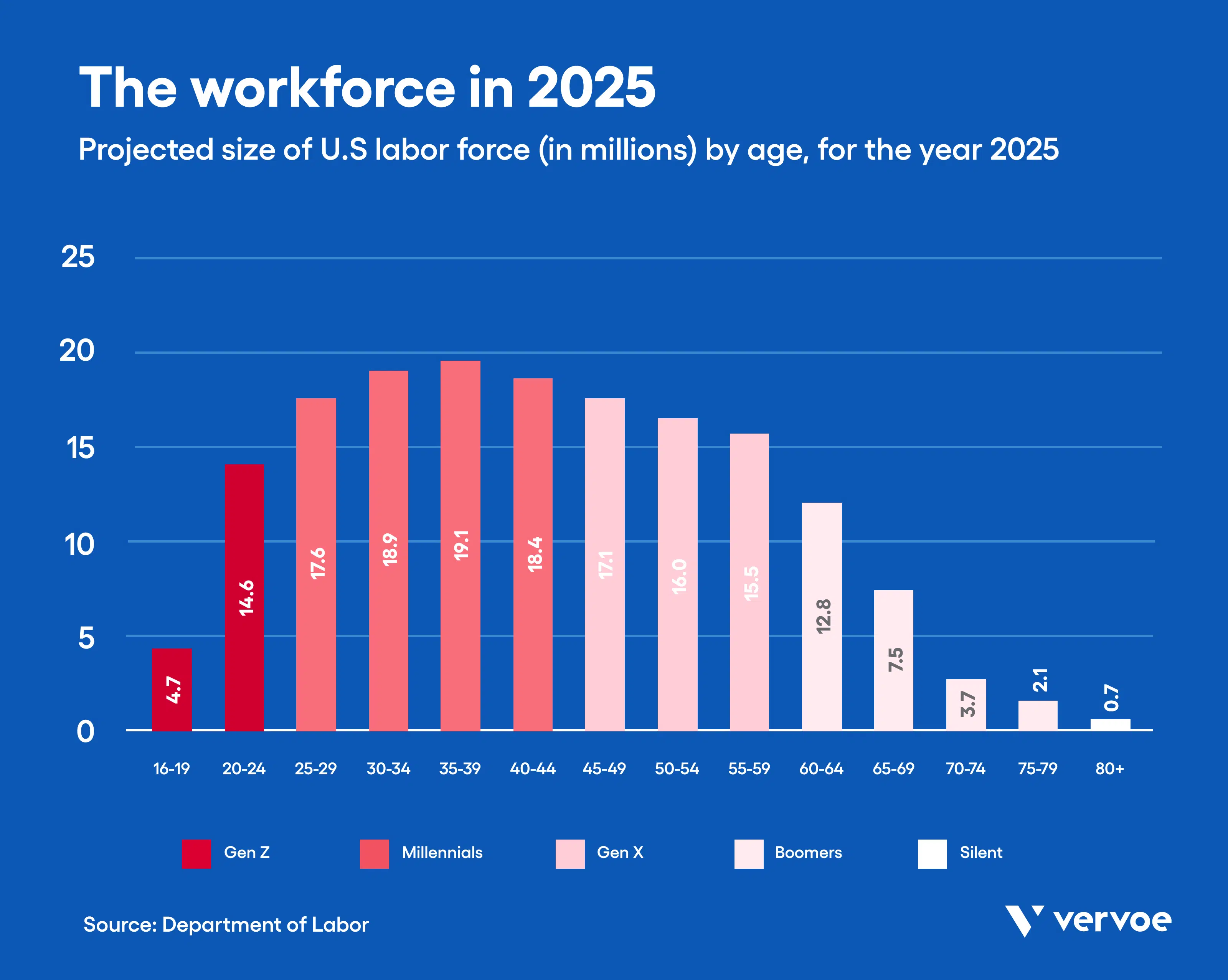
Generation Z, Millennials, Generation X, and Baby Boomers are anticipated to make up over 99% of the workforce. To achieve generational diversity, it’s important to understand the psychographics of each of these generations — what are their strengths, preferences, and work styles? From there, companies can begin building inclusive hiring practices, developing the work culture, and managing the generational gap at workplaces.
It’s also important to note that these descriptions of each generation are generalizations. While they can guide the resources and policies you put in place, these stereotypes should not be used to profile job candidates. Try to avoid letting these breakdowns of generations lead to more unconscious bias in your hiring and employment practices.
Baby Boomers
Baby Boomers were born between the end of WWII and 1964, putting these employees between the ages of 55 to 75, roughly. Unlike generations before them, many Baby Boomers are staying in the workforce longer and retiring later.
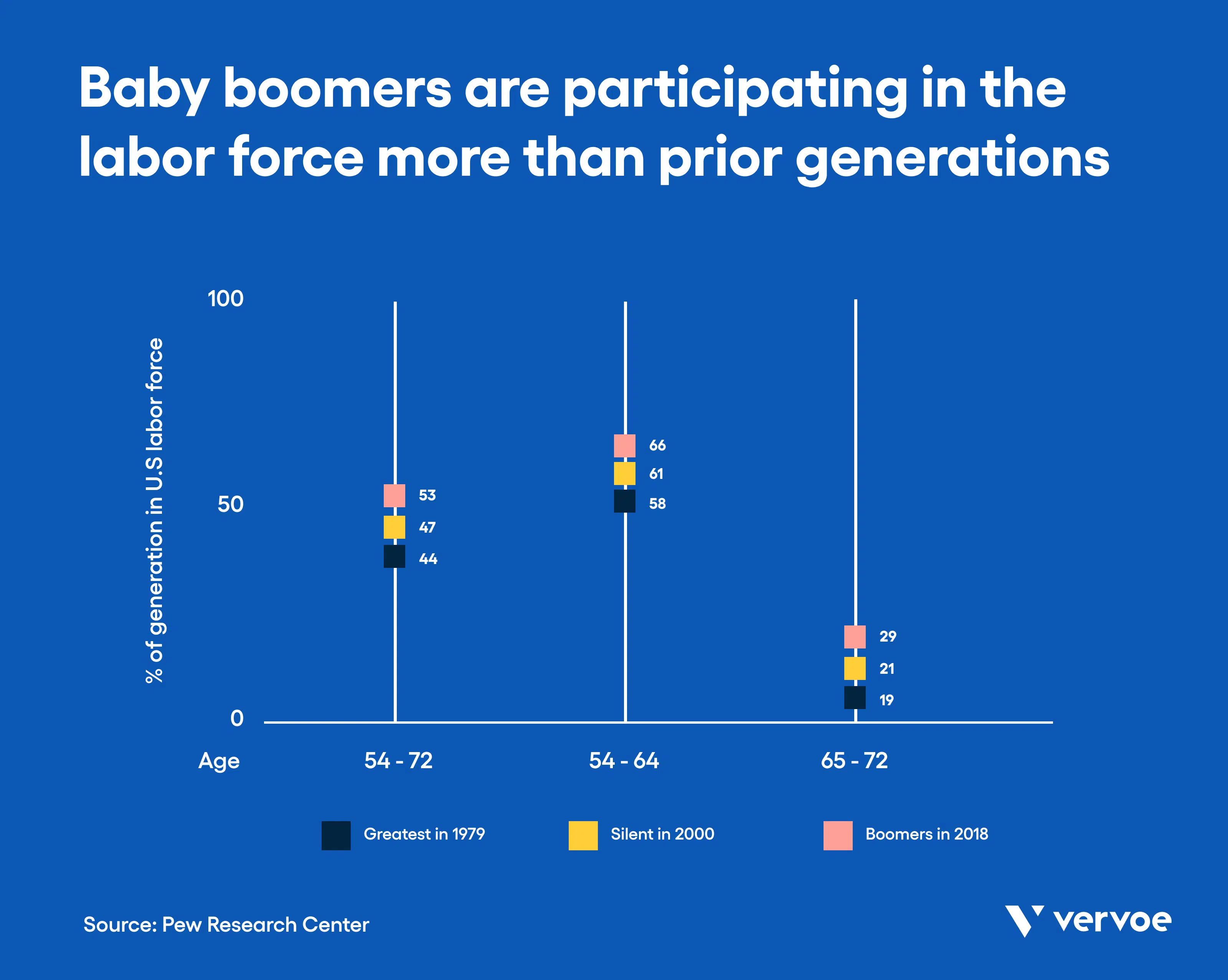
To understand this generation is to understand what the world was like as they grew up. “Baby boomers grew up in circumstances that previous generations couldn’t have imagined. They played in spacious backyards of detached suburban houses with mortgages subsidized by the G.I Bill”, Hubspot writes. “They completed secondary education and entered college in greater numbers than ever before. They spent summer vacations riding in family station wagons over newly completed interstate highways. They were the first kids to grow up watching TV.”
Baby Boomers were the first to experience a rising middle class and post-war consumerism. Research has found that these historic cultural shifts have created a group of employees who value:
- Long-term experience
- Career-oriented future planning and goals
- Independence in their decision-making
- Less commitment to authority and a workplace hierarchy than their parents, but still committed to structure
- Team-oriented work collaboration
“Boomers” seek advancement and are very goal-oriented in their careers. This group of employees tends to be hardworking and values in-person interaction. They want to be recognized for their accomplishments.
Generation X
Members of Generation X were born between the mid-1960s and the early-1980s. This group of workers is currently approaching the midpoint of their careers and potential peak-earning years.
Generation X (Gen X) has undergone a series of crises during their employment years. First, the dotcom bust of the 1990s; then, the financial crisis of 2008 and Great Recession. Likewise, Gen X grew up with minimum adult supervision: they were the first generation to experience both parents working outside the home, and afterschool programs or childcare were still relatively underdeveloped.
Over the past few years, Gen X has emerged as a largely ignored, and perhaps underappreciated, group of employees. “Gen X is ‘America’s neglected middle child’ and we don’t hear much about the group”, CNBC reports. “It seems that all eyes are on the slowly retiring baby boomers or the ascending millennials, now the world’s majority generation. But our recent study revealed that Gen X is playing a critical – yet underappreciated – role in leadership as organizations grapple with digital transformation.”
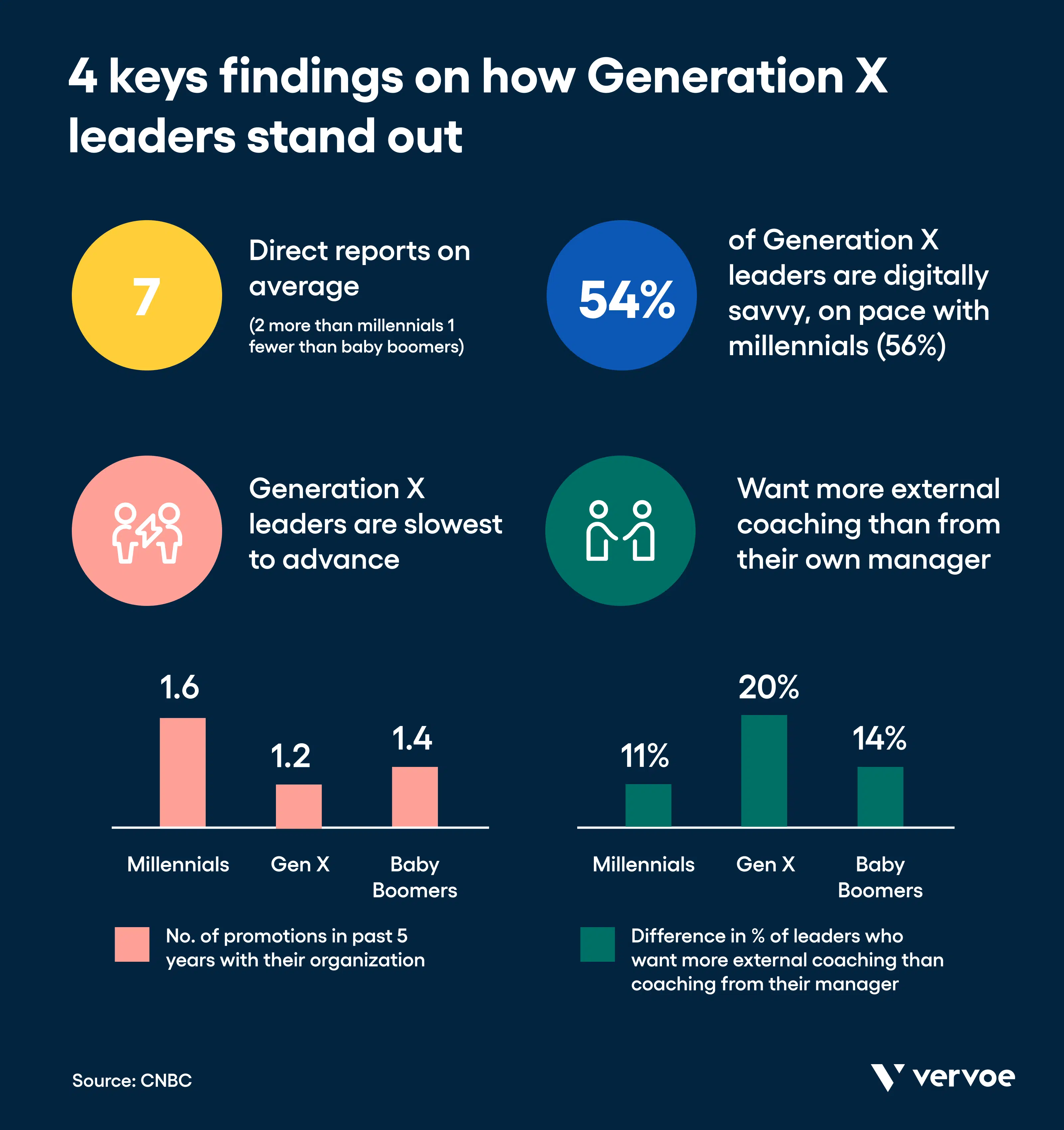
Just over 50% of all leadership roles are held by Gen Xers. These employees are seen as hard-working, adaptable, and digitally savvy. Though Gen X may not be considered digital natives, they are connected – sometimes more than younger generations. Here are a few more statistics that convey how Generation X workers are often overlooked and underappreciated.
- 67% of Gen X leaders are “effective in ‘hyper-collaboration’, and are working relentlessly to break down organizational silos” (CNBC)
- Gen X leaders, on average had only 1.2 promotions in the past 5 years; much lower when compared to Millennials (1.6 promotions) and Baby Boomers (1.4 promotions) during the same period of time. Gen Xers have been the slowest to be promoted. (CNBC)
- Gen X tends to be loyal employees: Only 37% contemplate leaving to advance their careers — compared to 42% of Millennials (CNBC)
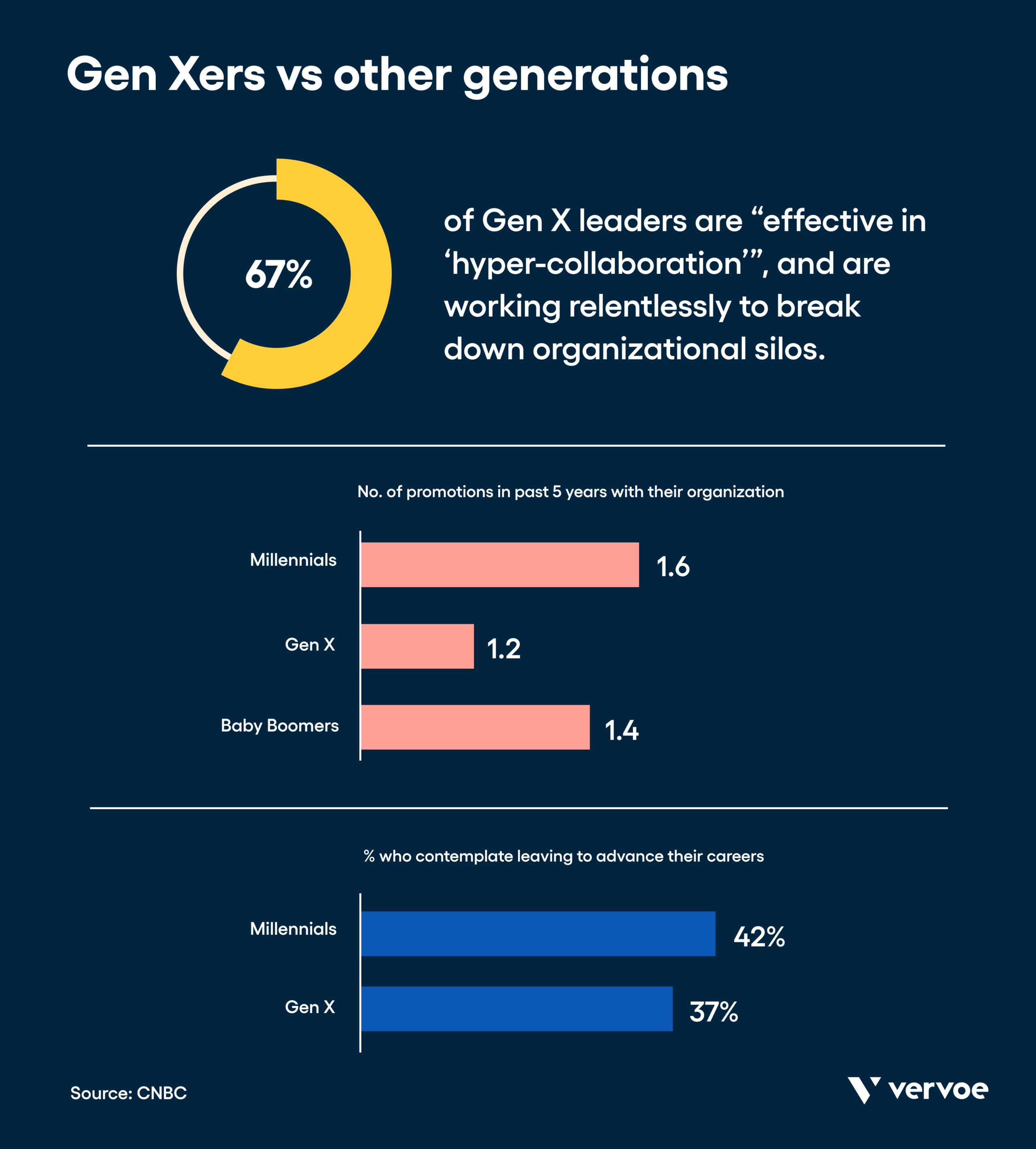
However, recent studies have raised alarms that Gen X may soon face an employment crisis. Research shows that hiring managers across the board considered employees and job seekers ages 45 and up to be the least prepared in terms of application readiness, fitness, and previous experience. Ageism and other unconscious biases may disproportionately impact Gen X over other generations.
Generation Y/Millennials
Generation Y, most commonly known as Millennials, are those who were born roughly between 1981 and 1996 (though some groups list Gen Y as those born up until 2004). They are also the largest generation by population in the U.S, overtaking Boomers due to large numbers of immigrants.
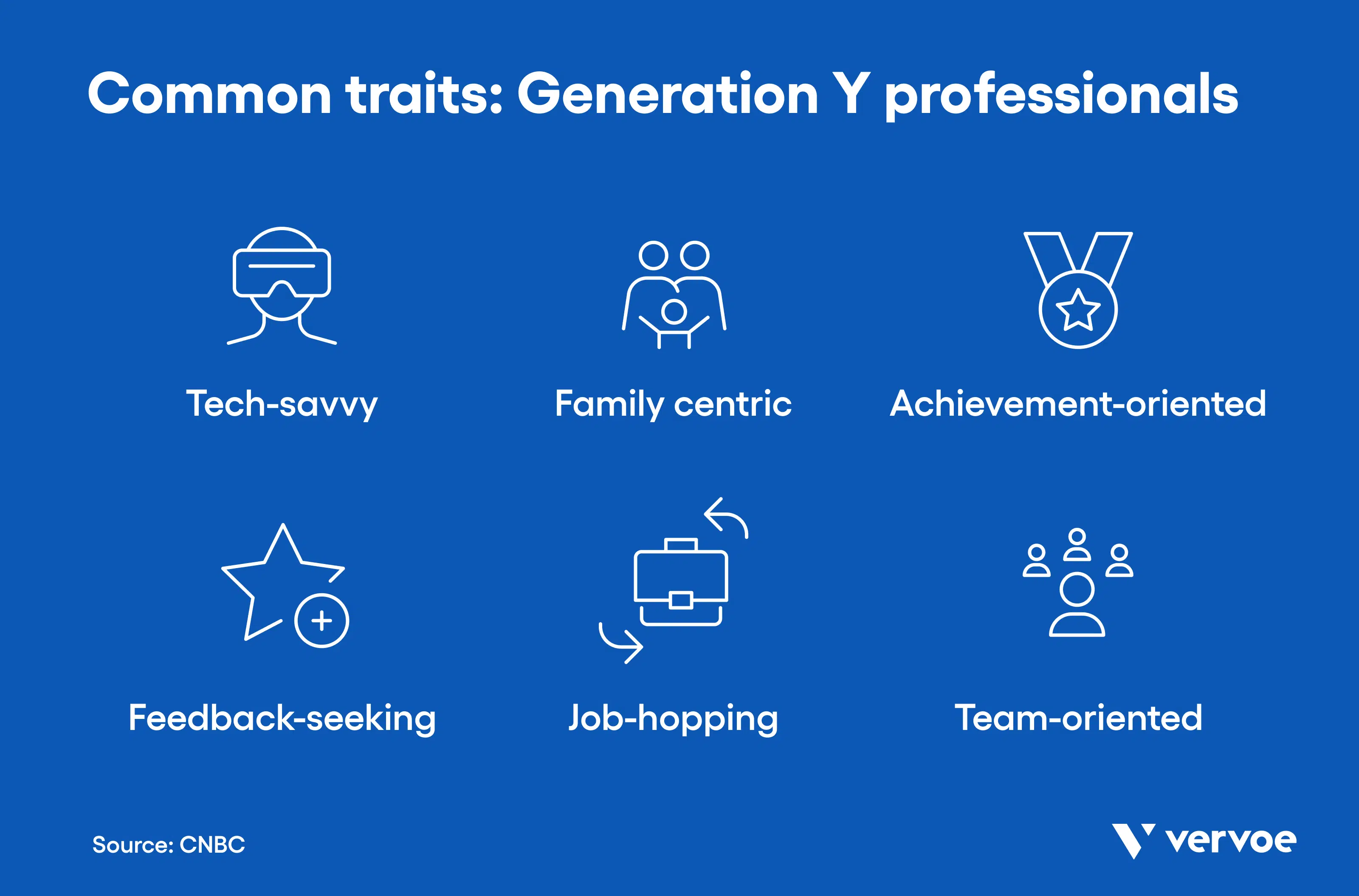
Millennials are perhaps the group of workers that get the most attention in the media and in the HR world. There are many misconceptions and stereotypes about Millennials, namely that they are lazy and entitled. Like the generations before them, Millennials were impacted by historical and cultural events that left a lasting impression.
Attitudes towards Gen Y, as well as their values and work style, are largely the product of their circumstances. Millennials came of age following the tragic events of 9/11 as well as the economic crisis of 2007. As Harvard Business Review writes, they’re “A generation with an undeserved reputation for disloyalty had to change jobs frequently simply to keep up with basic bills and crushing student debt. Together, these experiences contributed to a profile of a generation more likely to seek order in their world and meaning in their work”.
Most members of Gen Y are considered “digital natives”, people who grew up with the widespread use of technology. More than 90% of Millennials own smartphones and tend to be well-versed in social media. Perhaps because Millennials have grown up so connected, they value different aspects of their career.
“More than 50% of millennials say they would take a pay cut to find work that matches their values, while 90% want to use their skills for good”, Fast Company says. In a 2015 survey, Deloitte found that 7,800 future leaders from 29 different countries said the business world was getting it wrong. And some 75% said they felt businesses were focused on their own agendas rather than improving society, while only 28% said they felt their current organization was making full use of their skills.
Overall, Millennial employees seek to use their employment to make the world more compassionate, innovative, and sustainable.
Generation Z
Generation Z is generally regarded as anyone born between 1995 and 2015. Generation Z has grown up completely immersed in the internet. Smartphones, touch screens, and apps have been the norm since birth, unlike Gen Y, who can remember a time before wireless internet.
While Gen Z and Millennials may share some of the same characteristics, don’t lump them together. According to Hubspot, Gen Z values different things in the workplace than Millennials – starting with money. While Millennials put more emphasis on clear career direction and vacation days, 65% of Gen Zers say salary is their top priority.
Likewise, Gen Z has grown up in a time where racial, sexual, and gender equality are ongoing battles. The most diverse generation yet, Gen Z were kids during the Obama presidency and Clinton candidacy. Same-sex marriage has always been the norm: They don’t see why it would be controversial. Diversity to Gen Z matters in every dimension – not just in terms of race or gender, but also identity. Companies that prove diverse and inclusive are more likely to retain Gen Z workers.
Challenges of generational diversity in the workplace
There’s a common misconception that dealing with different generations in the workplace requires lots of conflict management. In reality, however, understanding generational differences in the workplace is no different than any other approach to creating an inclusive working environment.
Researchers at Harvard Business Review found that the generational differences among employees may be smaller than originally perceived. “Millennials only want to communicate with coworkers via text – and Baby Boomers don’t text, right? And you need to attract those tech-y Millennials with promises of flexible work schedules, but their older counterparts all want a traditional workday, correct? Well, actually, wrong.”
The researchers analyzed 20 different studies with almost 20,000 people of different generations. The outcome: While individuals may change what they need, are interested in or prefer over the course of their career, group differences based on age or generation aren’t supported.
In fact, what may be the issue isn’t the multi-generational diversity in the workplace, but rather the misperception that these differences exist. “These beliefs can get in the way of how people collaborate with their colleagues and have troubling implications for how we people are managed and trained”, HBR writes.
Ultimately, generational conflicts at work may stem from unconscious bias as much as from genuine differences in opinion or values.
Generational conflicts
Regardless of whether differences between employees of different generations are real or perceived, companies often need to mitigate the impact of generational differences in the workplace. Managing generations in the workplace can mean untangling different working or communication styles, as well as combating negative age-based stereotypes.
Internalized age-based stereotypes can also impact someone’s work performance. If an older employee is treated or told they won’t be technologically savvy, they are more likely to struggle through training for a new tool or platform. Generational stereotypes can become a self-fulfilling prophecy, fueling a conflict that has little to do with age and more to do with inclusion.
Companies need to understand these dynamics in order to design training and hiring practices that start to combat generational conflict. When managed properly, generational diversity offers a wealth of benefits to businesses – here’s how to capture those benefits.
How to embrace and manage generational diversity
The first step to avoid generational conflict and start to combat biases is to explain generational differences within the workplace. Openly talking about age-based stereotypes, hosting role-reversal exercises, and highlighting the ways in which age differences can bring success to the team overall help bring heightened awareness of biases in the workplace. Awareness is the first step toward becoming more forgiving of age differences.
In addition to having open dialogue among your team, take on some of these concrete steps to embrace multigenerational diversity at work.
Adapt to each employee’s life stage
Rather than thinking about your team members as Boomers or as Millennials, think about what stage of life each person is in. Take, for instance, flexible working conditions. Remote work can benefit employees across all generations. Some people are parents and need the flexibility to design their own workday around caretaking. Other employees are still completing school and may prefer working from home to allow them to finish a secondary degree. Adapting your work strategies to be able to work across different needs will make your company attractive to any generation.
Do not make age-based assumptions
Age-based assumptions are as dangerous as any other type of generalization. At best, you risk misunderstanding or underestimating your talent. At worst, you risk running into a discrimination lawsuit. Nearly one in three Baby Boomers who are dissatisfied with their jobs report that they have experienced age discrimination. It’s surprisingly common, and easy, to lean on generational stereotypes when managing across generations. Offer training and awareness to try to prevent this from happening.
Include everyone
Build generationally diverse teams to foster a greater understanding of everyone’s strengths and weaknesses. Offer leadership positions based on talent, rather than age. Create mentoring and reverse-mentoring programs to make sure workers of all ages learn from one another. The more inclusive you can be, the more likely you’ll build a cohesive group that supersedes generational stereotypes.
[Read more: The 8 Best Inclusive Hiring Practices For 2021]
Diversify communication styles
Regardless of age, everyone has different communication preferences. Broadly speaking, some generations prefer in-person communication more than others.
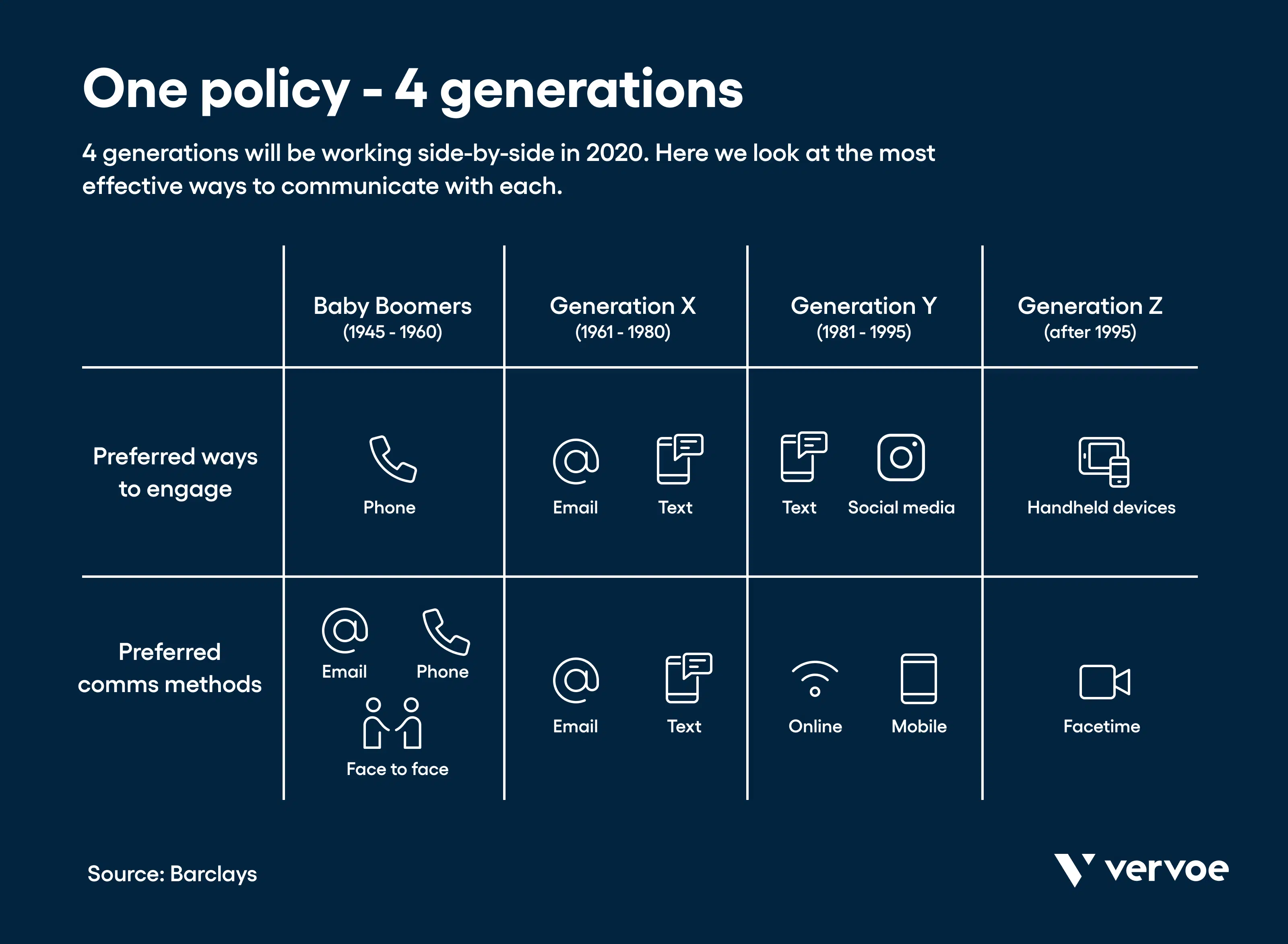
Send around a short survey to learn what preferences each employee has when it comes to communicating. Then, make sure the tools are in place to enable everyone to communicate comfortably. Maybe that means adding a Slack subscription or an office VoIP.
Create specific benefits
The benefits that will appeal to employees vary based on life stage – not generation. Baby Boomers and Millennials appreciate flexible work for different reasons. Consider designing benefits packages based on your employee’s needs. Here are some examples:
- Baby Boomers: phased retirement programs; training and professional coaching; volunteer opportunities; savings checkups and other financial advice
- Gen X: health benefits such as telemedicine, wellness programs, and onsite clinics; bonuses and pay rises; childcare and financial security
- Millennials: student loan repayment assistance; healthcare; flexible work and work-life balance; mental health support
- Gen Z: personal and professional opportunities for growth; telemedicine and other telehealth; financial planning and advice; flexible work; mentors and employee resource groups
As you can see, many of the benefits you may offer overlap between generations. Survey your team to learn what is important to them, and build benefits and compensation programs for each individual based on their unique position in life.
Prioritize building age-diverse teams
There are numerous ways to overcome age bias in the hiring process. Blind hiring is one such technique; skill testing is another. A tool like Vervoe combines the best of both processes to help recruiters make sure hiring decisions are made based on merit, rather than age.
Vervoe’s skills assessments software can be customized with questions and assessments that mimic the tasks required from the new hire. This assessment style allows candidates to perform tasks relevant to the job they’ve applied for and showcase their abilities in the process. AI automatically ranks results, so recruiters receive a list of the top candidates after their qualifications have been validated.
And, Vervoe is easy to use no matter how technologically savvy a candidate may be. Most skill assessments are mobile-friendly, which means that candidates can complete their tests anywhere and at any time.
Build these approaches into retention practices
Don’t limit your use of skill tests to the hiring process. Skill assessments can be used to make sure candidates are ready to take on a new project, test the efficacy of a training and development program, and identify leaders in the organization. Training, leadership, and new challenges at work can all keep employees engaged and motivated, which is key to building loyalty and improving retention.
[Read more: How To Measure Diversity, Equity And Inclusion]
Final thoughts
Managing different generations in the workplace can appear challenging on the surface. Each person brings different life experiences and values to the office. It’s this type of diversity that helps companies be more innovative, competitive, and profitable. Approach managing generational diversity in the workplace with the same mindset that you approach any other type of diversity: be inclusive in your hiring practices, and your business will benefit.
Get started improving your generational diversity by checking out our guide to the Top 25 Diversity Job Boards For More Diverse Hiring.
Interested in improving diversity and inclusion demographics at your company? Get started with our Diversity Recruitment Software




















